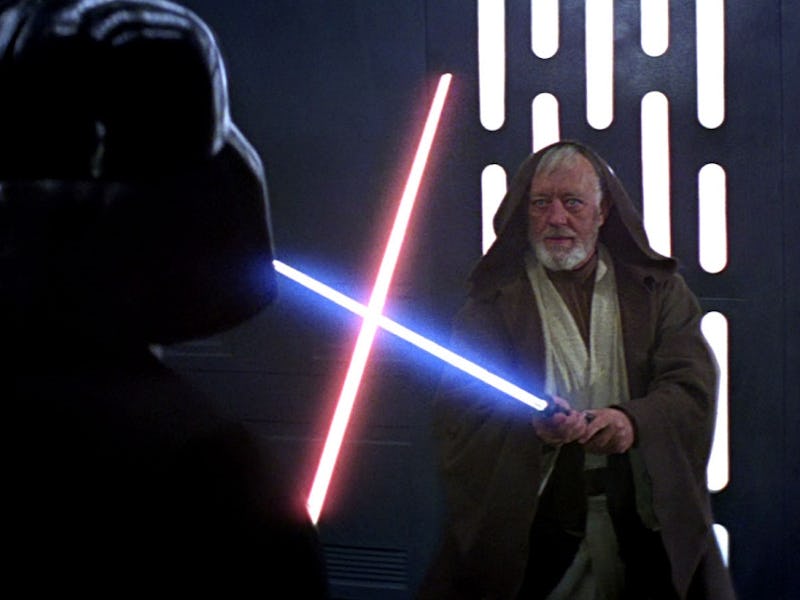The Mandalorian finally did something Star Wars has been teasing since A New Hope
'Chapter 13: The Jedi' brings the series back to the genre that inspired the entire franchise.

The latest episode of The Mandalorian was like nothing before. There were massive revelations, sweet moments, and some impressive standoffs and battles. At the same time, it was also tapped into a fundamental part of Star Wars in a way no other movie or show in the franchise has ever done before.
Here's how The Mandalorian Season 2 Episode 5 finally brought the samurai subtext of Star Wars to the forefront of its story.
Composer Ludwig Goransson once told The New York Times that Jon Favreau's explanation of the Mandalorian as a character was "a lonesome rider and a samurai." These twin inspirations run throughout The Mandalorian, but they also can be traced back to Star Wars' beginnings. Han Solo is the ultimate renegade space cowboy, and the strictness of the Jedi code evokes the code of the samurai lifestyle.
In fact, these two genres are more similar than you may think. Western movies borrowed ideas from samurai films since their genesis, and one of the most famous samurai movies, Kurosawa's The Seven Samurai, was remade in the U.S. as The Magnificent Seven. This influence went both ways, and the two genres were in regular conversation with each other throughout the '60s and beyond.
Who's your favorite new TV character in 2020? Take the Inverse fan-favorites survey!
Star Wars picked the best of both genres and baked it all into a space opera setting. Blasters and quips came from westerns, while swordfights and ceremony from the samurai. Probably the best known reference point for George Lucas' influence is another Kurosawa film, The Hidden Fortress, which told the story of two peasants who assist a princess from a dangerous situation, basically the premise of A New Hope.
"I decided that would be a nice way to tell the Star Wars story, which was to take the two lowest characters, as Kurosawa did, and tell the story from their point of view, which in the Star Wars case is the two droids,” Lucas said in a 2001 interview.
A still from 'The Hidden Fortress,' one of George Lucas's major influences.
Then came The Mandalorian, and every aspect of these genres was turned up a notch. Mando and Baby Yoda became a galactic Lone Wolf and Cub, complete with a protective cradle. In Season 2, the western influence was so blatant the premiere was basically a retelling of a John Wayne movie. It even brought a modern-day western character actor (Timothy Olyphant) in to play the marshal Cobb Vanth.
Every episode after that has been an exercise in how the Star Wars universe could be used to explore a different genre, be it the taxi driver movie in Chapter 10, pirates in Chapter 11, or a heist in Chapter 12. While none of the genres were major influences on The Mandalorian as a whole, they each had their own distinct style while still keeping with the general aesthetic of the series.
Chapter 13, "The Jedi," brings this genre-hopping full circle by bringing the show back to its roots — a good old-fashioned samurai story. Ahsoka is a vigilante attacking the magistrate stealthily under the cover of night. If you didn't know otherwise, you'd think some of these scenes came straight out of a Kurosawa film.
The very Kurosawa-esque scenery of 'The Mandalorian' Chapter 13.
In the same episode, we also get the story of a wise warrior being presented with a young apprentice. Ahsoka's time with Grogu (yes, Grogu, get used to it) feels like the most Star Wars moment of the entire episode, mirroring both Obi-Wan's encounter with Luke and Qui-Gon's interactions with Anakin. However, The Mandalorian diverges from tradition when Ahsoka rejects the offer to teach him. She's on her own mission now, one that somehow involves Grand Admiral Thrawn.
Though the episode also shouts out its western influences — like that epic shootout with Michael Biehn — the mood of the episode: the shadowy forest, the Eastern-style alarm bell, and the beskar staff vs. twin lightsaber combat are all homages to samurai culture. There were even "assassin droids" who climbed the roofs of the village like ninjas, though they were no match for Mando's blaster.
After 43 years of samurai-influenced media, Star Wars finally leaned into the genre hard, and the result is what an increasing number of fans are calling the best episode of The Mandalorian episode yet. Perhaps this is the start of a renaissance of Star Wars' original influences, bringing the franchise back to what made it great so many years ago.
At the very least, it's nice to see series co-creator Dave Filoni (who wrote and directed this standout episode) overtly giving credit to the international influences that often go unsung in The Mandalorian and in Star Wars at large.
The Mandalorian Season 2 is now streaming on Disney+.